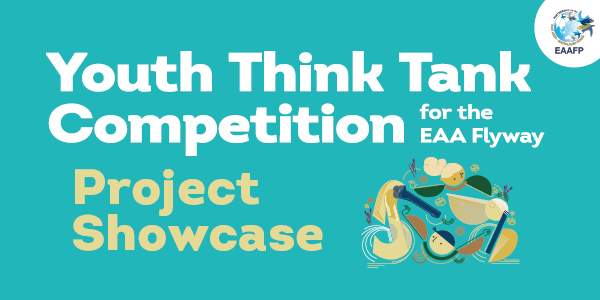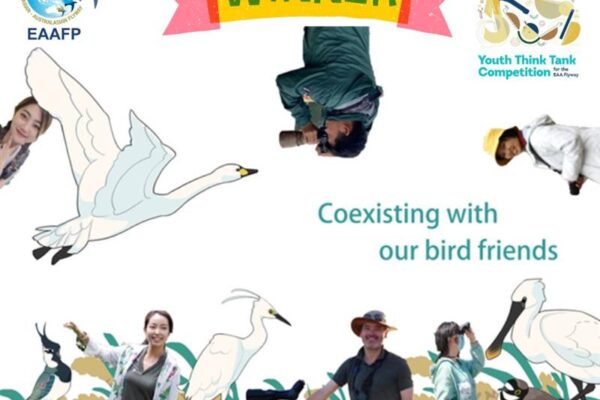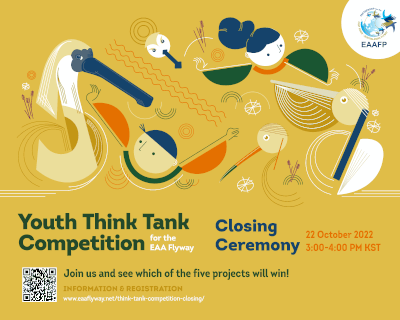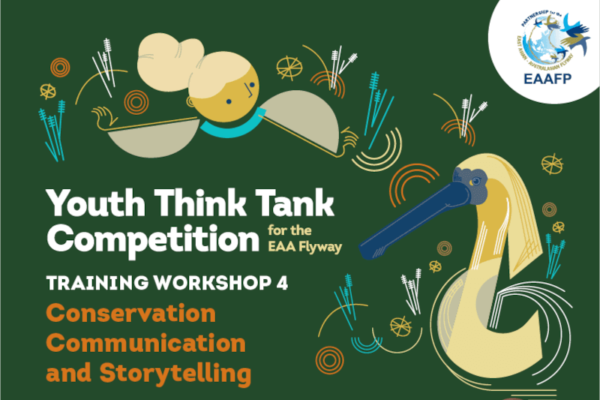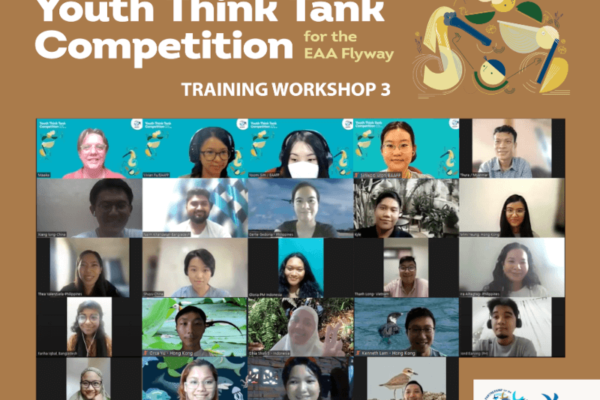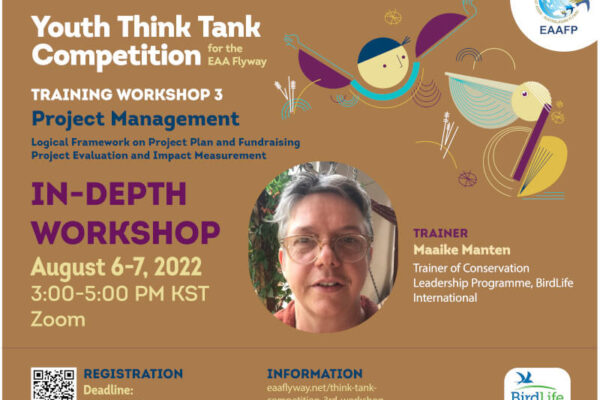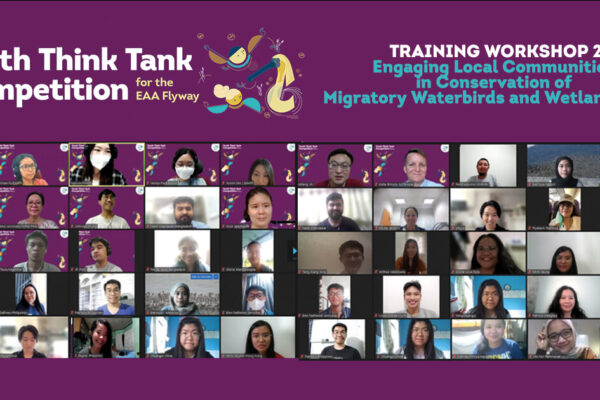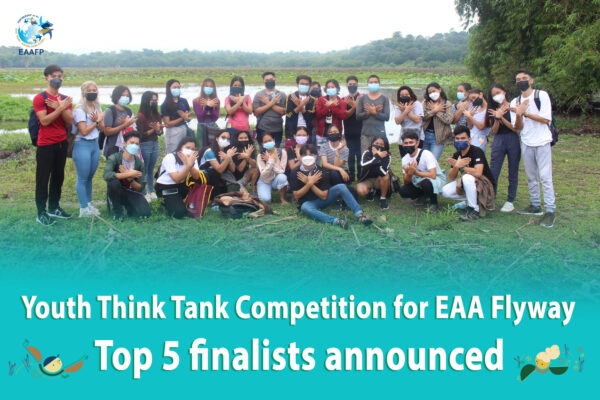-
Introducing the Youth Think Tank Competition Project Teams
The year-long journey for our 5 Youth Think Tank Competition finalist teams has finally come to a close. Although there were challenges, like the COVID pandemic, each team has successfully implemented their project between January and October 2022. Let’s learn more about what each project team has accomplished and would like to share! 1. Grand Final Winner: Team “Dining wetland for birds and people” Dining wetland for birds and people Team ©️ Dining wetland for birds and people “Through interviews with local people we learned about the challenges farmers are facing in balancing the demands of food production and birds in paddy fields. To raise awareness of the issues, gather opinions and ideas and promote the importance of biodiversity, we reached out to the local community and citizens more broadly, especially young people across the country, through online seminars, a photographic competition, and popular science articles. Our motto was: "know more, care more and act more.” - Dining Wetlands for Humans and Birds Team Share the video: link Project location: Nanqiao County, Fengxian district, Shanghai, China Team members: Shuyu Hou, Luyao Chen, Yuhan Li, Xinchen Bu, Yin Zhang Project Summary: Birds, our flying neighbours, are liked and inspire curiosity among citizens. However, they can also cause problems, especially in farmland communities. This project focused on a modern farm site in Nanqiao county, located in the suburbs of the mega-city, Shanghai, where the study site is typical of urban agricultural communities - affection for their flying neighbours but also worry about the damage they cause to crops. Objectives Collect baseline data about biodiversity and community perspectives Build capacity for the Nanqiao community and the broader public about knowledge of birds and their importance Increase awareness and motivate action for bird conservation What had been delivered: Four baseline ecological surveys, using a mixture of camera traps and transects. These surveys recorded 61 bird species and 3 mammals species, filling the data gap and laying the foundation for conservation actions. Two in-person meetings with the local stakeholders to understand the local situation, build a common understanding and agree to collaborate. Received 102 completed questionnaires from the citizens, with 40% from local community. Hosted a "birds in cropland" theme photo contest, attracting 300 votes and reaching a readership of over 1,000 by two articles. Designed and produced stickers, postcards and shopping bags of local bird species of Shanghai, to increase awareness of bird conservation. Published six popular science articles on social media to promote bird knowledge, reaching 2,200 readers. Hosted one online webinar, featuring two keynote speakers from this team and local partners, reaching 800 people. The post-event survey showed that the webinar significantly increased the audience's knowledge of birds PPT Presentation: link Read the report: link Flickr Gallery: Coming Soon! 2. Team “Project Lupad" Project Lupad Team ©️ Project Lupad “The youth is the hope of our nation and the present generation. Let us all remember this quote from Baba Dioum "In the end we will conserve only what we love; we will love only what we understand; and we will understand only what we are taught." Together let us teach and share our love for migratory birds and wetlands so that many people will understand and conserve the things that we love.” - Project LUPAD Team Share the video: Coming soon! Project location: Buayan, General Santos City, the Philippines Team members: Kyle V. Aboy, Melanie P. Genita, Loyd Joredell H. Curit, Roana Mae C. Caguliodo Project Summary: Project Lupad was created because of the need to promote awareness about migratory birds at Barangay Buayan in General Santos City. The overall goal of the project is to narrow the knowledge gap on migratory birds by engaging the youth in communication, education, and public awareness (CEPA) campaigns for migratory birds. The project had three phases: head, hands, and heart. The specific aims of the project are as follows: 1. enhance the youth's knowledge of migratory birds and their ecology through online lectures; 2. develop the youth's skills in making and communicating advocacy or campaign materials for the conservation of migratory birds and their habitats; and 3. raise community awareness about the local issues confronting various wetlands in General Santos City. We started the Head phase by engaging the youth in an online course about migratory birds which ran for one month; this was done via Google Classroom where we posted learning modules and assessed the participant’s learning and via Zoom where we invited speakers to further discuss the topics in the learning modules. The second phase is Hands, where the youth have undergone skills workshops to support migratory bird education and advocacy campaigns. The third phase is Heart, the community engagement caravan where the newly trained youth ambassadors for migratory birds produced their own CEPA materials for the public and the local Buayan community to see. These CEPA materials include infographics, digital arts, PowerPoint presentations, and flash cards which were published physically and digitally and translated into English, Filipino, and Bisaya. 79 participants joined phase 1 of the activities. For phase 3 approximately 200 people visited the exhibit and an additional 150 houses were visited during the house-to-house campaign via a community engagement caravan. PPT Presentation: link Read the report: link Flickr Gallery: Coming soon! 3. Team “Seabirds of Tubbataha” Seabirds of Tubbataha Team ©️ Seabirds of Tubbataha "The Youth Think Tank Competition for Flyway taught us how to create and execute a project from scratch - learned in theory through training courses and practical applications through our project implementation. The Seabirds of Tubbataha project has inspired us to value and better understand seabirds. Along the way, we had the opportunity to collaborate with and learn from individuals who share our interests, including this competition’s organizers, seabird experts, site managers, and our mentor, Micha. It has been a challenging yet enriching experience!" - “Seabirds of Tubbataha” Team Share the video: link Project location: Tubbataha Reefs Natural Park and World Heritage Site, the Philippines Team members: Gerlie T. Gedoria, Anthea Kristha C. Valenzuela, Ira Patricia Alitagtag Project Summary: Tubbataha Reefs Natural Park (TRNP) is the largest no-take marine protected area in the Philippines. It is both an ASEAN Heritage Park and a World Heritage Site. TRNP also became an EAAFP Flyway Network Site in 2015. The two islets of TRNP support over 20,000 seabirds and serve as important nesting and rookery grounds for seven different seabird species, four of which are migratory. Seabirds are highly pelagic, spending most of their time at sea. Their limited interaction with humans due to their isolation may be one reason they are not popular subjects of environmental education activities in the Philippines. Through this project, we designed and implemented a webinar on seabirds and produced a video focusing on the plight of the Black Noddy worcesteri subspecies that was premiered during the webinar. The project aimed to increase awareness amongst Filipinos about seabirds, their importance, and the threats they face, a hundred people at a time. We aimed to highlight the conservation needs of the Black Noddy, which is threatened by loss of nesting habitat, and of Tubbataha generally as a vital seabird breeding ground in Southeast Asia. Through dissemination of the film at the webinar and beyond, we hope to inspire early career and future conservationists to espouse seabird conservation and glean recommendations for improving our management efforts. More than 100 participants joined the various activities. PPT Presentation: link Read the report: link Flickr Gallery: Coming soon! 4. Team “Environmental Education in Dongting Lake” Environmental Education in Dongting Lake Team ©️ Environmental Education in Dongting Lake “On the basis of comprehensive investigation and mastering the natural education resources of Dongting Lake, we used the Project-based Learning (PBL) teaching method to develop a natural education curriculum with the theme of wetlands and birds – I am an ornithologist. The course is divided into two parts: indoor bird class and campus nature game, including five links: wetland discovery, understanding waterfowl, wetland and waterfowl, wading beak competition, migration of migratory birds and nature notes. At the same time, supporting textbooks, teaching aids and course effect evaluation forms are designed. Subsequently, the team organized four environmental education activities in Matang Central Primary School and Mingde Primary School in Yueyang County, with a total of 120 students participating. The children showed great interest in the activity. The interaction between teachers and students in the indoor classroom was continuous, the atmosphere was warm, and the natural games were intense and wonderful. A seed of caring for wetlands and birds has been successfully sown in children's young minds. As children grow up, this seed will take root and sprout, guiding them to approach, love and protect nature and Dongting Lake.” - Edu. in Dongting Lake Team Share the video: link Project location: East Dongting Lake National Reserve, Yueyang City, Hunan Province, China Team members: Xianglong Tang, Wenzhi Xiao, Yu Zhang, Shuangxi Yang Project Summary: Based on a comprehensive survey of Dongting Lake's environmental education resources, we developed and designed the Dongting Lake localization curriculum with wetland cognition, bird cognition and protection as the main contents by using Project-based Learning (PBL) teaching method, a new method of environmental education, and combining the characteristics of wetland and bird-based environmental education resources in Dongting Lake area. We have designed the supporting textbook "Dongting Lake Nature Education Knowledge Manual" and the knowledge folding book "Dongting Home Nature Sharing" to assist the development and implementation of the course. We developed an evaluation system of environmental education curriculum effect, which includes environmental knowledge, environmental attitude and environmental behaviour measurement, and scientifically and reasonably evaluated the effect of activities. We contacted two primary schools in the nature reserve to organize environmental education activities, which included indoor bird classes and outdoor games. During the activity, students are generally interested in the curriculum. No matter whether it is indoor classroom or campus activities, children show great interest, which successfully inspires their love for birds, wetlands and nature, leaving unforgettable memories for children and achieving good teaching results. A total of 120 students joined the activities. PPT Presentation: link Read the report: link Flickr Gallery: Coming soon! 5. Team “Rediscover Kei Island Waterbirds” Rediscover Kei Island Waterbirds Team ©️ Rediscover Kei Island Waterbirds "We are thankful for the opportunity and support from EAAFP throughout the project. We learn to manage our budget wisely because our research site is remote. One of our team members got to learn from the start to do birdwatching and for her it was a very nice experience. Through this project we got to meet people from different backgrounds, and we also learned and gained insight from them to tackle challenges in the field. We hope to do more activities at Kai Islands in the future." - Rediscover Kei Island Team Share the video: link Project location: Kei Islands, Southeast Maluku, Indonesia Team members: Gloria Pratidhwani Manggalagita, Dhia Shofi Salsabilah, Ida Nur Rahmawati Project Summary: The Kei Islands in Indonesia are a vital point for monitoring the East Asia Australia Flyway Network. Unfortunately, bird migration monitoring and observation in the Kei Islands is rarely carried due to its remote location in the waters of the Banda Sea, Indonesia. The last research about bird biodiversity conducted in Kei Island was in 1994. Now Kei Island become new emerging tourist spot in eastern Indonesia. Migratory bird is commonly seen in the Kei Islands and this phenomenon also attracts tourists. This project has conducted waterbirds monitoring in two islands, namely Kei Kecil Island and Mangur Island to update monitoring and lists of Kei Islands birds using line transect methods by walking and by boat or ferry. Upon 22 days of observation (29 March 2022- 19 April 2022), only 20 waterbirds species and 17 land bird species found. Targeted species, Far Eastern Curlew (Numenius madagascariensis) and Great Knot (Calidris tenuirostris). Total of 35 Far Eastern Curlews spotted in Ohoidertawun Beach and Ngurtavur Beach, but no Great Knot was observed. Bird watching has been introduced to residents by doing birdwatching session with children in Mangur and discussion session with total 20 person reached. From fourteen observation sites there are two important habitat that need to be manage sustainably which are Ohoidertawun Beach and Ngurtavur Beach. Both of the sites are favorite tourism spots in Kei Islands, hence the threat of habitat loss and anthropogenic disturbance are higher. Discussion with three tourism actors have been conducted three times and but no code of conduct of eco-friendly & migratory bird-friendly has been drafted yet. PPT Presentation: link Read the report: link Flickr Gallery: Coming soon! For more about the Youth Think Tank Competition for the EAA Flyway click here. The Closing Ceremony was held on 22 October, 2022, click here to learn more.
Continue reading -
Winner of the Youth Think Tank Competition for the EAA Flyway revealed!
After a wonderful 2-years, the Youth Think Tank Competition for the EAA Flyway came to a close on Saturday 22nd October 2022. To extend the momentum of 2020 Flyway Youth Forum which became the first spark for dialogue amongst youth in the EAA Flyway on conservation of wetlands and migratory waterbirds, the Youth Think Tank Competition for the EAA Flyway was launched on August 2021 to encourage and enable youth to actively engaging in conservation. Taking in the feedback from the forum participants, who commented that they wanted further opportunities to actively take part in wetland and migratory bird conservation, the EAAFP Secretariat, with the help of various advisors from the partnership, organized the Competition to provide the opportunity to fulfil the needs. The competition was targeted at Youth between the ages 18-29. During Phase I, a total of 37 applications from 14 countries were submitted. Each project was carefully reviewed by the esteemed judge panel. Eventually, 5 selected teams from China, the Philippines, and Indonesia would receive funding from the Secretariat to implement their projects. The result was announced in December 2021: 1. Project Lupad (Philippines) 2. Seabirds of Tubbataha (Philippines) 3. Environmental Education in Dongting Lake (China) 4. Dining Wetlands for Humans and Birds (China) 5. Rediscover Kei Islands (Indonesia) To help guide the youths with their projects, each team was assigned a mentor, who would coach them along the project implementation. The mentors were helped them to tackle various challenges they faced, one of which proved to be the COVID pandemic. All teams are able to overcome the challenges and successfully implemented their projects from January to October 2022. The second part of the programme is capacity building. The EAAFP Secretariat, with support from recruited 4 youth volunteers and EAAFP interns which formed the Youth Organizing Team, organized workshop series of 4 sessions, inviting distinguished speakers and trainers to cover key topics: 1) Understanding global agenda for environment and how youth are engaged 2) Engaging Local Communities in Conservation of Migratory Waterbirds and Wetlands 3) Project Management 4) Conservation Communication and Story Telling. Most workshops comprised of a webinar and an in-depth training workshop. The 4-part workshop series reached a total of 75 different participants from 16 countries within and beyond the Flyway. The Pre- and Post-workshop surveys filled out by the participants of each workshop indicated an increase in knowledge and skills for each topic and the majority of participants also expressed that they found the workshops to be useful in their line of work. On 22nd October, project teams, mentors, judges, and many others gathered for the Closing Ceremony. The ceremony kicked off with opening speeches from Mr. Doug Watkins, Chief Executive of the EAAFP Secretariat and Mr. Casey Burns, EAAFP CEPA Working Group Chair, followed by a short summary presentation of the Competition by Ms. Vivian Fu, EAAFP Communication Officer, who headed the entire competition. Each team then gave 10–15-minute presentations on their projects. After that, the Grand Final Winner selected by the judges was announced by Mr. Doug Watkins. And the Grand Final Winner was Team “Dining Wetlands for Humans and Birds” from China. Image: Winning Team “Dining Wetlands for Humans and Birds" with Mr. Doug Watkins, EAAFP Chief Executive and Mr. Chris Rostron, one of the judges of the Competition The winning team will be awarded an opportunity to join an international events (e.g. Ramsar COP14) and will also be offered a position as a youth representative for the CEPA Working Group. Those who attended the closing ceremony left amazed and moved by the creativity and capabilities of the 5 youth teams. Youth Think Tank Competition once again proves the importance and strength of youth in the conservation field. Following the success of the programme, the Secretariat will continue to find further opportunities for youth to engage in EAAFP work and activities. Image: Closing Ceremony Group Photo We would like to express our gratitude to the advisors: Mark Edison Raquino (Global Youth Biodiversity Network – South East Asia); Suh Seung Oh, Ramsar Regional Center -East Asia; Tomoko Ichikawa, Ministry Of Environment Japan; Yamme Leung, World Wide Fund – Hong Kong; Casey Burns, EAAFP CEPA Working Group; Gab Mejia, Youth Engaged in Wetland, Josefa Cariño Tauli, Global Youth Biodiversity Network. The mentors: Ding Li Yong, BirdLife International (Asia Division); Terry Townshend, Paulson Institute; Sayam U. Chowdhury, EAAFP Spoon-billed Sandpiper Task Force, Micha Jackson, The University of Queensland. Our special thanks goes to the honorable judges: Mika Tan from ASEAN Centre for Biodiversity; Beom-Sik Yoo, The Secretariat of the Ramsar Convention; Spike Millington, International Crane Foundation; Chris Rostron, Wildfowl & Wetlands Trust (WWT); Anastasia Cronin, National Geographic; and Casey Burns, EAAFP CEPA Working Group. We would also like to thank the amazing organizing team: Ho Bun Yu (Orca), Jord Gadingan, Thura Htike, Frances Alvares (designer) and from the Secretariat Yoomi Sim, Sinwoo Won, Yoonjae Bae, Yuji Lim, Yeonju Park, Hyoin Kim, Sewon Lim, Yunjoo Cho and Yoon Lee. For more on the Youth Think Tank Competition For playback of each workshop: Workshop 1 Workshop 2 Workshop 3
Continue reading -
Closing Ceremony of Youth Think Tank Competition for EAA Flyway
After a wonderful 2-year-long journey, the Youth Think Tank Competition for the EAA Flyway is coming to an end….
Continue reading -
4th Training Workshop of Youth Think Tank Competition for EAA Flyway Conservation Communication and Storytelling
Objectives Communication and storytelling play a key role in conservation. To better equip youth, especially future conservation leaders, with skills in storytelling and scientific…
Continue reading -
Youth Think Tank Competition for EAA Flyway – 3rd Training Workshop focusing on Project Management
On 6th – 7th August 2022, the Youth Think Tank Competition for the East-Asian Australasian Flyway (EAAF) had its 3rd training workshop aimed…
Continue reading -
Third Training Workshop of Youth Think Tank Competition for EAA Flyway is about Project Management
3rd Training Workshop of Youth Think Tank Competition for EAA Flyway Project Management Objectives Project Management skills are essential to the effectiveness and increase the impact of the conservation effort. To better equip young people, especially future conservation leaders, the East Asian – Australasian Flyway Partnership (EAAFP) organized a series of training workshops, with the 3rd workshop focusing on project management. The two-day workshop will cover principles of the logical framework of project plan and fund-raising, as well as project evaluation and impact measurement. The trainer will lead on exercises and the use of tools. Date: 6th – 7th August, 2022 (Saturday and Sunday) In-depth Workshop – Day 1 “Logical Framework on project plan and Fund-raising” Date and Time: 6th August, 2022, 15:00 – 17:00 KST (2 hours) Quota: 30 people Livestream on EAAFP Facebook: https://www.facebook.com/eaafp In-depth Workshop – Day 2 “Project Evaluation and Impact Measurement” Date and Time: 7th August, 2022, 15:00 – 17:00 KST (2 hours) Quota: 30 people Registration link: https://forms.gle/AJbpda5XL4389Ps29 Registration Deadline: 1st August 2022 Tool: Zoom Target Audience: Young conservationists, green groups for youth, local and international NGOs staffs, university students Eligibility for In-depth workshop: Aged 18-29 (under 30 on the date of application) Applicants with a nationality from EAA Flyway countries will be given priority to join Applicants to the EAAFP Youth Think Tank Competition will be given priority to join Important notice: We are using Zoom for the webinars and workshop. Please download the Zoom App (https://zoom.us/download) prior to the workshop. Successful applicants to the In-depth workshop will receive a separate email for the Zoom link and workshop rundown. It is a series of four workshops, only those who attend at least two In-depth workshops of the Youth Think Tank Competition Programme will receive a certificate of participation. Trainer Ms. Maaike Manten Trained as a political scientist in Amsterdam, the Netherlands, Maaike started working for BirdLife International in the year 2000. Since then she has worked for BirdLife in the UK, Kenya, Fiji and Rwanda, first as the institutional fundraiser for Africa and the Pacific, and later as the Regional Implementation Team (RIT) leader for the Critical Ecosystem Partnership Fund (CEPF)’s investment programmes in the Eastern Afromontane and the Mediterranean Basin biodiversity hotspots. Maaike has been working with CLP since 2009, providing project design, proposal writing and fundraising training to young conservationists in Africa, Asia, Latin America and the Middle East. She is also the co-author of the ‘Institutional Fundraising for Conservation projects’ manual that is available in 5 languages here. She is currently based in Kigali, Rwanda, and working as a freelance fundraiser and trainer. Click [here] to learn more about Maaike. Supporting Organizations Topics of Upcoming Workshops: More information about the Youth Think Tank Competition for the EAA: https://www.eaaflyway.net/thinktankcompetition/ 4th Workshop: Conservation Communication and Story Telling (early September 2022) Playback of the previous workshops, click [here]. ( https://www.youtube.com/playlist?list=PLVu-SI5onbMvPfamqQ5i84OpFx2CI6QaC)
Continue reading -
Youth Think Tank Competition for EAA Flyway – 2nd Training workshop
On 28th - 29th May, the Youth Think Tank Competition in the East Asian-Australasian Flyway (EAAF) engaged youth participants with a webinar and in-depth training workshop on Engaging Local Communities in Conservation of Migratory Waterbirds and Wetlands. One in a series of workshops that aims to build capacity for young conservationists on wetland and migratory waterbirds conservation in the flyway across various disciplines, the 2-day virtual workshop was organized by the EAAF Partnership Secretariat with the help of the youth organizing team. More than 100 youth actively participated in the discussions and workshops. Day 1 The workshop opened on 28th May 2022 with a webinar, “Understanding Nature-based Solutions and Local Community Engagement in Conservation of Migratory Waterbirds and Wetlands.” The 1-hour webinar focused on presentations from speakers, Ms. Kathryn Bimson, Programme Officer for IUCN Regional Asia Office, and Mr. Jiefeng Jin, Conservation Officer for the International Crane Foundation. The first presentation, given by Ms. Kathryn Bimson, was an introductory presentation on Nature-based solutions and was followed by an introductory presentation on Engaging local community in conservation by Mr. Jiefeng Jin. Both presentations helped participants ease their way into the topic and the in-depth training workshop, “Engaging Local Communities in Conservation of Migratory Waterbirds and Wetlands” that came afterwards. [PPT Materials] Introduction to Nature-based Solutions (link) / Introduction to Engaging Local Community in Conservation (link) The in-depth workshop was led by Ms. Mercy Kariuki, Programme Officer (Local Engagement and Empowerment Programme) from BirdLife International and focused on “Engaging Local Communities in Conservation of Migratory Waterbirds and Wetlands”. She emphasized the significance of Free, Prior and Informed Consent (FPIC) in the process of conservation and how the work is increasingly adopting a human rights-based approach. To delve further into the topic, the presentation was followed by a case study by Mr. George Ndung’u Muigai, Founder of the Cranes Conservation Volunteers, on the conservation of Cranes in Kenya. During his presentation, Mr. Muigai shared on-the-ground experiences engaging with the community and exchanged practical advice with the youth participants. [PPT Materials] Engaging Local Communities in Conservation of Migratory Waterbirds and Wetlands (link) / Conservation of Cranes in Kenya (link) The breakout session, participants discussed the positive and negative relations between conservation and people, so that they could learn to think in different perspectives – from local communities to conservation. The participants shared actual experiences from their respective regions and project implementations. Day 2 The in-depth workshop continued on 29th May with a short summary presentation from Ms. Mercy Kariuki before delving into a case study from Amy M. Lecciones, Executive Director of the Society for the Conservation of Philippine Wetlands, Inc who tackled Empowering Communities for Managing Agricultural Wetlands. In her presentation, Amy shared the case in Paligui Wetlands (a part of the greater key biodiversity area of Candaba Wetlands) of how local farmers were trained to be local eco-tour guides. Amy enumerated some key activities for community engagement and social challenges with the proposed conservation measures taken in Paligui. (PPT Materials) Following next was a case on Hong Kong Fishpond Conservation Scheme presented by Mr. Johnson Chung of The Hong Kong Bird Watching Society. Mr. Johnson shared how local fishermen helped to enhance the biodiversity of fishponds within the Ramsar Site and being an important player in the conservation project. Johnson shared different ways to motivate the local communities as well as the general public to support the management agreements. The outputs were beyond conserving migratory birds but also benefitted local fishermen while maintaining traditions and cultures in Hong Kong. (PPT Materials) The last case study was presented by Professor Wataru Kitamura of Tokyo City University on the Little Tern project. He shared how the once-disappeared population of Little Tern was brought back to the urban areas in Tokyo Bay area. The project demonstrated the success and need for a strong scientific base, and how it can be developed into a good citizen science programme to engage the locals and general public garner their support. It was also an innovative solution to create habitats for the birds with the use of the rooftops of building in the middle of the city. (PPT Materials) After that, the participants broke out into groups to practice stakeholder analysis of the different case studies that were presented. Youth participants shared their perspectives on identifying stakeholders and ideas on engaging them with participatory conservation objectives. [Webinar] Understanding Nature-based Solution and Local Community Engagement in Conservation of Migratory Waterbirds and Wetlands [In depth Workshop] Engaging Local Communities in Conservation of Migratory Waterbirds and Wetlands: Session 1 [In depth Workshop] Engaging Local Communities in Conservation of Migratory Waterbirds and Wetlands: Session 2 Evaluation: All 20 participants had an increase in learning for the topic of nature-based solutions. In the pre-workshop survey, half of the participants responded that they had some familiarity with the topic. In the post-workshop survey, however, 90% responded they were now familiar or ‘ready to go pro’ with nature-based solutions. All participants were satisfied and found what they learned during the workshop useful in their volunteer/work. Participants rated these three components with the highest scores: 1) trainers and speakers of the workshop (4.5/5); 2) case study presentations (4.5/5); 3) contents of the workshop (4.5/5). The most valuable learnings/ takeaways for the participants were: 1) Free, Prior and Informed Consent, 2) Stakeholder mapping and analysis and 3) Nature-based Solutions. Takeaways: Participants wrote that most valuable learnings/ takeaways for the workshop was: 1) Free, Prior and Informed Consent, 2) Stakeholder mapping and analysis and 3) Nature-based Solutions. In the words of the Flyway youth: “What really stayed in my head and in my notes also is the quote "Recognizing diversity and engaging stakeholders helps in building legitimacy, developing innovative solutions, enhancing transparency, and most importantly, in upholding social equity." “It is evident that we are currently experiencing biodiversity loss. Hence, it is a must to take action. However, there are various factors that we need to consider first. For example, the effects of the conservation programs that we want to implement on the local communities and vice versa. As conservationists, we should understand the social contexts. A way for us to plan everything is to create a stakeholder analysis. It is a process for us to be able to map and identify the target people before the project begins. Acknowledgment The Youth Think Tank Competition for the EAA Flyway Organizing Team acknowledges the great contribution from the speakers and trainers: Mercy Kariuki, George Ndung’u Muigai, Amy M. Lecciones, Johnson Chung, and Wataru Kitamura, as well the youth organizing team: Frances Alvares, Jord Earving Gadingan, Oscar Yu, Thura Soe Min Htike, Yeonju Park, Yuji Lim and Yoomi Sim. The webinar was moderated by Ms. Yoon Kyung Lee, External Relations Manager of the EAAFP Secretariat. The in-depth workshops were co-moderated by Ms. Yuji Lim, Ms. Yeonju Park, Ms. Yoomi Sim from the EAAFP Secretariat and Mr. Thura Soe Min Htike from Myanmar. Ms. Vivian Fu, Communication Officer of the EAAFP Secretariat led the coordination of the workshop. To learn more about the speakers and trainers click here. For more on the Youth Think Tank Competition click here.
Continue reading -
Second Training Workshop of Youth Think Tank Competition for EAA Flyway is about Local Community Engagement
2nd training Workshop of Youth Think Tank Competition for EAA Flyway - Understanding Nature-based Solutions and local community engagement in conservation of migratory waterbirds and wetlands During the 1st EAA Flyway Think Tank Competition Workshop last year, we gained insight into the high level of interest that youth participants had in environmental issues, especially wetlands and migratory waterbirds. Many participants showed their eagerness to learn more about conservation and how they can engage in the implementation of local actions to decision-making. To better equip young people, especially future young professionals to take part in the conservation of migratory waterbirds, their habitats, and local communities relying on the wetlands, the EAAFP Secretariat is pleased to organize a 2nd training workshop with a focus on local community engagement. Objectives: To introduce the concept of Nature-based Solutions as a tool that links local community engagement and conservation To enhance knowledge and skills on local community engagement for conservation projects Date: 28th – 29th May, 2022 (Saturday and Sunday) Part 1. Open webinar “Understanding Nature-based Solutions and local community engagement in conservation of migratory waterbirds and wetlands” Date and time:28th May, 2022, 1500-1600 KST (1 hour) Registration: https://us02web.zoom.us/meeting/register/tZUkfuipqDIrHdF_cnd72-FUQOP4ZMRFt8KZ Livestream on EAAFP Facebook: https://www.facebook.com/eaafp Part 2. In-depth workshop “Engaging Local Community in conservation of migratory waterbirds and wetlands” Date and time:28th & 29th May, 2022, 1700-1900 KST (2 hours/day) Quota: 30 people Registration: : https://docs.google.com/forms/d/e/1FAIpQLSebISr3L5X2u0cbNI5Q0LOPzvWX4AcOlwxx00P1BV9a6-_lgw/viewform Deadline of registration: 13th May, 2022 Tool: Zoom Target Audience: Young conservationists, green youth groups., local and international NGOs young staffs, university students Eligibility for In-depth workshop: Aged 18-29(under 30 on the date of application) Applicants with a nationality from EAA Flyway countries will be given priority to join Applicants to the EAAFP Youth Think Tank Competition will be given priority to join Important notice We are using Zoom for the webinars and workshop. Please download the Zoom App (https://zoom.us/download) prior to the workshop. Successful applicants to the In-depth workshop will receive a separate email for the Zoom link and workshop rundown. It is a series of four workshops, only those who attend at least two In-depth workshops of the Youth Think Tank Competition Programme will receive a certificate of participation. Programme Part 1 Webinar – "Understanding Nature-based Solutions and local community engagement in conservation to migratory waterbirds and wetlands" Keynote speakers Ms. Kathryn Bimson Programme Officer, Water, Wetlands and Nature-based Solutions for Climate at the IUCN Asia Regional Office. Ms. Kathryn Bimson has been working on wetlands in Southeast Asia for the last nine years, and is currently coordinating the regional implementation of a number of projects related to Nature-based Solutions and wetlands in the Lower Mekong Basin. Ms. Bimson also supports the Secretariat for the Indo-Burma Ramsar Regional Initiative, working closely with the governments of Cambodia, Lao PDR, Myanmar, Thailand and Viet Nam to strengthen the implementation of the Ramsar Convention in the region. Ms. Bimson holds an MSc. in Biology from the Prince of Songkla University, Thailand, and a BSc. in Biology from Fairfield University, USA. She previously received a National Geographic Young Explorer’s Grant to study private sector engagement in coral reef restoration, and spent her first year in Thailand as an English Teaching Assistant with the US Fulbright Program. Mr. Jiefeng Jin Yangtze Basin Program Manager, China Programme, International Crane Foundation (ICF) Mr. Jiefeng Jin started his conservation career in 2009 and joined ICF in 2014. To conserve the Critically Endangered species Siberian Crane and other three crane species as well as their wetland habitats, he maintains and develops good relationships with various partners, donors and other stakeholders, designs and implements ICF conservation strategies in wintering area of Yangtze River Basin, particularly in Poyang Lake where over 98% of the world population of Siberian Crane together with almost all of the western population of White-naped Crane are wintering. He works closely with national and international research institutes to advise on management actions for protecting cranes and other waterbirds. He is committed to promoting public awareness and engagement, such as recruiting and training volunteers from local communities and colleges to carry out education and outreach for the public. He has a deep interest in working with local communities to safeguard their resource base while restoring landscapes important to cranes. He obtained his second M.S. degree in Environmental Conservation at the University of Wisconsin-Madison in 2020. Part 2 In-depth workshop “Engaging Local Community in conservation of migratory waterbirds and wetlands” Key Trainer Ms. Mercy Kariuki Programme Officer, BirdLife International Ms. Mercy Kariuki is a Kenyan conservationist with an interest in community conservation work especially in Africa and is a recent graduate of MPhil in Conservation Leadership from the University of Cambridge. She has worked for BirdLife International (both in Nairobi & currently in Cambridge office) for about 10 years in various capacities & positions. Through the BirdLife Local Engagement and Empowerment Programme, Mercy has worked with BirdLife Partners supporting community-led conservation initiatives, developing community conservation projects/proposals, managing projects, meeting local communities to conduct capacity assessments among other activities that involve community engagement. Mercy enjoys outdoor activities such as birdwatching, hiking and mountain climbing. Case Study Speakers for In-depth Workshop Mr. George Ndung’u Muigai Founder, Cranes Conservation Volunteers Prof. Wataru Kitamura Associate Professor, Department of Restoration Ecology and Built Environment, Faculty of Environmental Studies, Tokyo City University Ms. Amy Lecciones Executive Director, Society for the Conservation of Philippine Wetlands, Inc. Mr. Johnson Chung Project Manager, Hong Kong Bird Watching Society Supporting organizations: Topics of upcoming workshops: 3rd workshop: Project management, evaluation and impact assessment, and fund-raising (6-7, August, 2022) 4th workshop: Communication (story-telling and scientific communication) and project evaluation, impact measurement (September, 2022) More information about the Youth Think Tank Competition for the EAA:https://www.eaaflyway.net/thinktankcompetition/ Playback of the workshop: https://www.eaaflyway.net/2022/06/10/eaaf-youth-think-tank-2nd-workshop/
Continue reading -
Young people in Asia take actions to conserve wetlands and migratory waterbirds
Youth Think Tank Competition for EAA Flyway Top 5 finalists announced On 23rd December, 2021, we announced the results of the…
Continue reading

